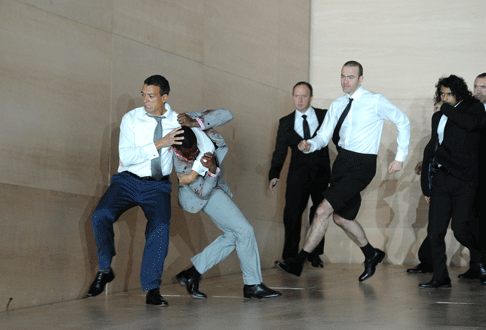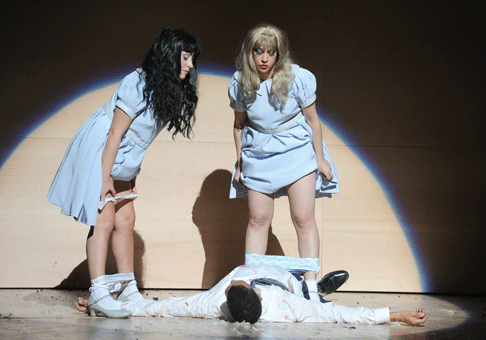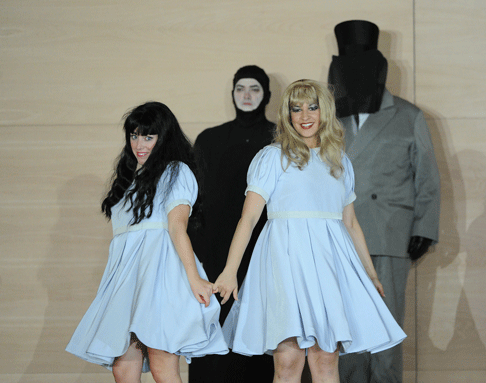Rameau’s
operas made a revolutionary impact in their day, giving rise to vehement
confrontation between two, warring musical factions at the French court of
Louis XV, as the champions of the conservative Lully and controversial Rameau
fought for operatic and cultural supremacy.
Yet, Rameau remains relatively rarely performed today, and so anticipation
for the first Rameau opera to be presented at ENO was naturally considerable.
However, after witnessing director Barrie Kosky’s Castor and Pollux
- his company debut and a co-production with Komsiche Opera, Berlin, where
Kosky has recently been appointed Intendant — one might have been forgiven
for thinking that the opera simply boils down to legs and feet.
Perhaps before I go on, I ought to acknowledge, as I will later expand, that
musical standards throughout were high and that some of the production’s
eclectic assemblage of motifs, concepts and images were thought-provoking and
potentially revealing. But, the absence of ‘particularity’ of time and
place ultimately rendered the various symbols rootless and gratuitous. Gestures
became gimmicks.
Thus, lower limbs and freakish footwear were visually ubiquitous. Garishly
stocking-ed legs; stamping, twisting lower limbs — all that was visible of
the chorus as the cavorted behind half-lowered back-drops; the feet of the
half-buried Castor protruding from his earthy grave; the disappearing toes of
Pollux slipping in pursuit of his brother into the realms of the Underworld;
then, the exposed thighs of the sisters, Télaïre and Phébé as they
slithered and writhed up and down the earthy burial mound, or, poised above the
prostrate Pollux, whipped up their skirts and dragged down their knickers, and
another pair, and another pair … If the directorial foot fetish waned,
thankfully, after the interval, the chorus’s lower limbs replaced by a row of
heads sporting freakish Hallowe’en headgear, the motif was resurrected in the
closing scenes of the opera, as twinkling stardust decorated the discarded
boots of Castor and Pollux (the brothers now having ascended to immortal
realms) — a rather earthbound image for this moment of supreme
transcendence.
If such observations seem facetious, I would contend that matters of costume
and gesture would matter less if they did not interfere with the music or the
drama. Or, if they merely distracted rather than disrupted, even destroyed.
For, frequently, Rameau’s vigorous, energised score seemed trampled into
submission. Thus, as the introductory instrumental passages initiated the mood
and ambience of the conflicts to come, the rhythms and textures succumbed to
elephantine clomping, as Laura Tatulescu’s Phébé stomped about the stage
like a sulky brat, bewailing her fate and pounding the walls in frustration.
This established an irritating precedent. Scarcely an entrance was not
accompanied by a fury of footfalls, with the result that the soloists’
poundings often obliterated the precisely nuanced accompaniments to their own
and each other’s recitatives — disastrous in a work where every gradation
of colour, tempo and harmony underpins a textual or dramatic detail.
 Roderick Williams as Pollux and Omari Bernard as Lyncaeus
Roderick Williams as Pollux and Omari Bernard as Lyncaeus
If the protagonists were not throwing themselves, and each other, noisily
about the stage, then the chorus was rushing here and there, frenetic stamping
accompanied by demented hand-weaving and wiggling. Seated at times on the very
edge of the stage, fore-grounded legs dangling over the orchestral pit, they
could not jump up and down, so they bounced inanely on their behinds
instead.
Over one half of Rameau’s score is dance music, but in this production the
oft changing rhythms and tempi of the orchestral passages, which fluidly
interweave between the long recitatives and flexible arioso sections, were
overshadowed by such, apparently intentional, cacophonous stage business and
clamour. Kosky and conductor Christian Curnyn have left 70% of Rameau’s
dances in place, but as the director explains in a programme
‘conversation’, took the decision to have “no dancing in the production.
We do other things with the dance music”. There is indeed a medley of such
‘other things’: psychotic jerking about, the now obligatory nudity scenes,
some ‘horror’ episodes imported from a B-movie. But, Rameau’s dances are
much more than mere divertissements; they elucidate character and
plot, and the challenge is to find a way of integrating the dances into the
emotional momentum which builds rapidly and frequently to hugely passionate
climaxes. (It’s perhaps not inconsequential that the last time a major UK
opera company performed Rameau was almost 15 years ago, when American
choreographer, Mark Morris staged Platée at Covent Garden.)
 Laura Tatulescu as Phoebe, Roderick Williams as Pollux and Sophie Bevan as Telaïre
Laura Tatulescu as Phoebe, Roderick Williams as Pollux and Sophie Bevan as Telaïre
Designer Katrin Lea Tag’s stage was itself bare and bleak, a harshly lit
panelled cube, the only ‘props’ and setting being two plastic folding
chairs and a pile of brown earth. Certainly if Lully’s operas were
characterised by special effects and spectacle, then his rival Rameau eschewed
extravagance in favour of an intense emotional focus. The “timeless”,
unspecified locale was designed to concentrate our attention on “the
constellation of human emotions of love and jealousy inherent in the piece”,
to allow us to focus on the drama; but, I found that the intrusion of an
assemblage of random, fantastical, and farcical elements hindered empathy with
the protagonists’ essential ethical dilemmas; stripped of its classical
restraint and nobility, the opera’s psychological realism was lost.
The question which lies at the centre of the opera is: which is the
stronger, fraternal or sexual love? The mortal Castor is brother to Pollux, who
is the son of Jupiter and therefore immortal. Both brothers love Télaïre, but
although betrothed to Pollux she, like her sister Phébé, adores his earthly
sibling. Phébé’s jealous plotting brings about shattering tragedy and loss,
but also inspires loyalty, selflessness and love. Following epic trials and
travails, the brothers, after several ‘rescue missions’ to dark regions of
the after-life, are united in celestial paradise as the constellation Gemini,
Castor’s altruism and self-sacrifice leading Jupiter to grant him immortality
also. The two women remain alone on earth.
As noted in the programme, in his conversation with Edward Seckerton, Barrie
Kosky responded to the suggestion that we “will care about the people in this
piece” with an assertion that “You do, which I always find quite
difficult”, and this I feel is the heart of the problem with his conception,
which focuses overwhelmingly on melancholia, loss and hell as abstract concepts
and overlooks the human, and redemptive, dimension of the myth. The problem is
clarified when Kosky remarks that he is mystified about the reasons why Jupiter
appears for a second time, notes the brothers’ extreme self-sacrifices and
rewards them by transporting them to the stars. But this, surely, is the heart
of the piece? Nobility of spirit and self-sacrifice underpin the unbreakable
bonds between brothers.
 Laura Tatulescu as Phoebe, Sophie Bevan as Telaïre, Andrew Rupp as High Priest of Jupiter and Henry Waddington as Jupiter
Laura Tatulescu as Phoebe, Sophie Bevan as Telaïre, Andrew Rupp as High Priest of Jupiter and Henry Waddington as Jupiter
Such nobility seemed lacking at crucial moments in the production. Thus,
when Pollux shows such admirable self-denial in relinquishing Télaïre and
endorsing her marriage to his brother, in Kosky’s eyes Castor should
demonstrate his appreciation of his sibling’s selflessness by cavorting
wildly like an over-excited adolescent. Similarly, when Jupiter shows Pollux
— who has agreed to give up his immortality in return for Castor’s freedom
— a vision of the heavenly delights which he would enjoy in eternity,
Pollux’s unswerving selflessness embodies the essential truth of human,
brotherly love. However, here the parade of the pleasures of paradise — the
squirming and squealing sisters, pre-pubescent in gingham dresses and white
ankle socks — seems more like to send Pollux fleeing rapidly to Hades rather
than clutching selfishly at the rewards of immortality.
As is perhaps apparent, much was asked of the singers: they endured on-stage
burial, clambered upon precarious mounds, sang principal arias bedecked in
Hallowe’en hoods, flung themselves beneath dangerously descending backdrops
in a manner which would have impressed 007 himself — and they performed
gamely, bravely and at times wondrously, coping well with the particular
demands of the French ornamentation.
The heroic journeys undertaken primarily find their equivalent in lengthy
musical episodes of recitative, music of great intensity and flexibility,
characterised by subtle nuances and troubling contradictions. The rapid changes
of tempo, tonality and instrumentation were most pertinently appreciated, and
their dramatic meaning conveyed, by Roderick Williams as Pollux. He had no
problems with the registral demands of the role, producing sincere gravity at
the bottom and vibrant earnestness at top. Dignified throughout, even when
dragged violently around the stage by his feet, by the enraged Lyncaeus,
Williams’ rich, beautiful baritone conveyed a gamut of emotions from despair
and disillusion to happiness and hope.
The role of Castor demands a light, high tenor capable of agile passage work
and ringing projection; Allan Clayton proved himself skilled in both regards,
as he drew the audience into his tragic journey.
Télaïre has all the best tunes, and Sophie Bevan certainly made the most
of them. Her second act aria mourning the death of Castor was spell-binding in
its beauty and elegance, and was wonderfully underpinning by expressive playing
by the bassoon and flutes.
As Phébé, Laura Tatulescu’s was dramatically compelling, but while her
voice is one of power and penetration, her rendition was not always wholly in
keeping with the French baroque style. She did not always produce a consistent
tone or sustain a long line, which made both musical and dramatic sense, in the
extended recitatives.
Ed Lyon was superb in his two minor roles, as the Athlete and Mercury. His
vigorous, nimble high tenor eased through the florid passage work; indeed the
athleticism of his singing in the former role was in marked contrast to his
visual presence as Mercury: for this was a droll Mercury, his wings flapping
limply as lamely flopped about — more Eric Morecombe or Mr Bean than soaring
servant of the gods.
As Jupiter, Henry Waddington was secure but not as authoritative as he might
have been; but then he did spend the entire opera with a black veil masking his
face which can’t have helped establish an impression of superhuman majesty.
Bass Andrew Rupp demonstrated striking focus as Jupiter’s High Priest, though
even he had to battle against his skeletal mask and trailing white fingers
(à la Edward Scissorhands?).
The orchestra of ENO, reduced in size, coped admirably with the noisy
intrusions from the stage. The instrumentalists were raised up from the deep
pit, to enhance balance and clarity, and this afforded a rare view at the
Coliseum of the conductor and players. From the first, Curnyn adopted a
flexible, muscle style, aiming for springy rhythms. Although in the overture
some of the string playing was a little laboured, and the ensemble not always
precise, when warmed up the instrumentalists gave an energised reading of
Rameau’s robust rhythmic score; by the end, a truly thrilling fleetness
characterised the rapid string motifs. Curnyn was ever alert to Rameau’s
varied and idiosyncratic instrumental textures, and impressively realised the
radical musical architecture of the form, with its fluid movement between
recitative, arioso, dance and chorus.
The ENO chorus, having been asked to cavort, giggle, strip and adopt an
array of silly costumes, sang with conviction. Occasionally, particularly when
huddled in a gaggle at the rear of the stage, they struggled to keep up with
the propelling tempi in the pit, but presumably that will improve with
familiarity as the run proceeds.
Amanda Holden’s translation was uncontroversial although, in the light of
the bare stage platform and other idiosyncratic directorial decisions, there
were some non sequiturs. Holden did not quite rise to the challenges
presented by long recitatives in eighteenth-century French, and the rhythmic
patterns of some phrases was unnatural and awkward; moreover, she often changed
syllable on the resolving pitch of rising cadential motifs, which seemed rather
clunky and ‘unpoetic’.
Commenting on the effect of his mingling of realism and fantasy, Kosky
concludes: “It becomes apparent that we’re actually going nowhere: hell is
earth, and earth is hell, and heaven is hell and it’s on earth.” Despite my
own misgivings, there was admittedly much applause for the cast and creators at
the curtain call (and a few howls too); so my own view may be unrepresentative
… but at times it felt as if this production really was going nowhere, and
that hell was indeed “here and now”; fortunately some heavenly singing and
celestial playing redeemed matters.
Claire Seymour
Click here for video clips and other information regarding this production.



